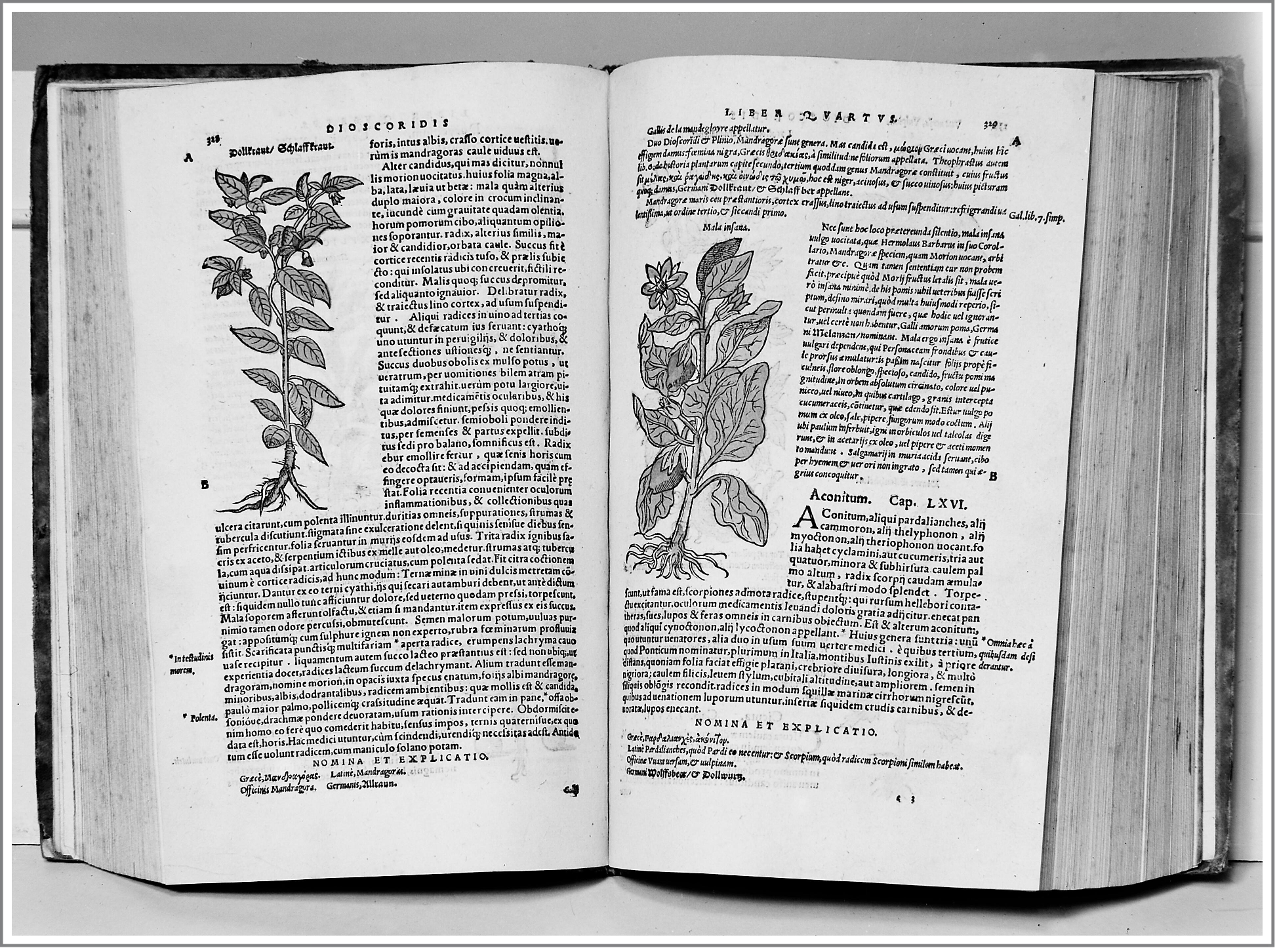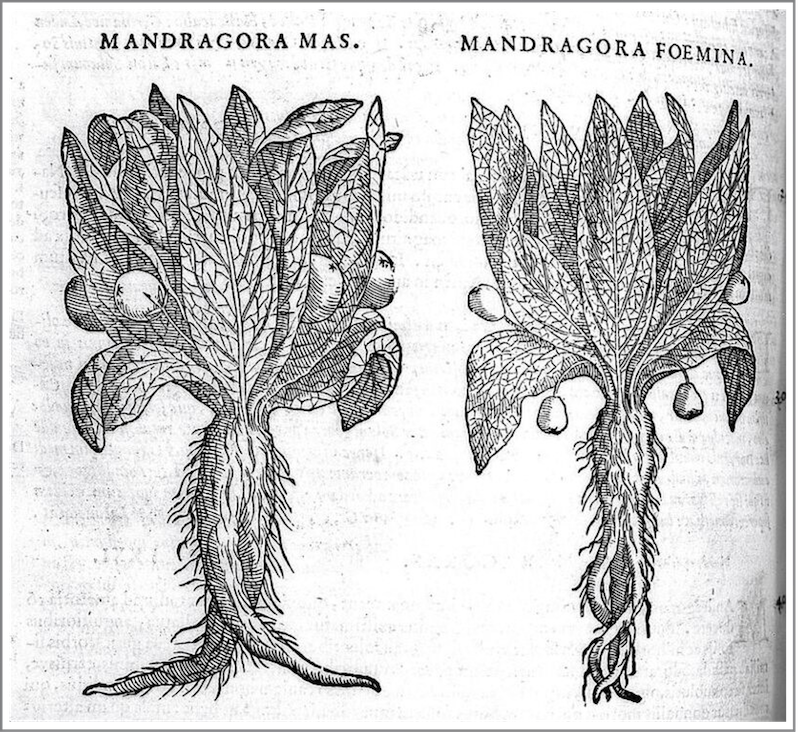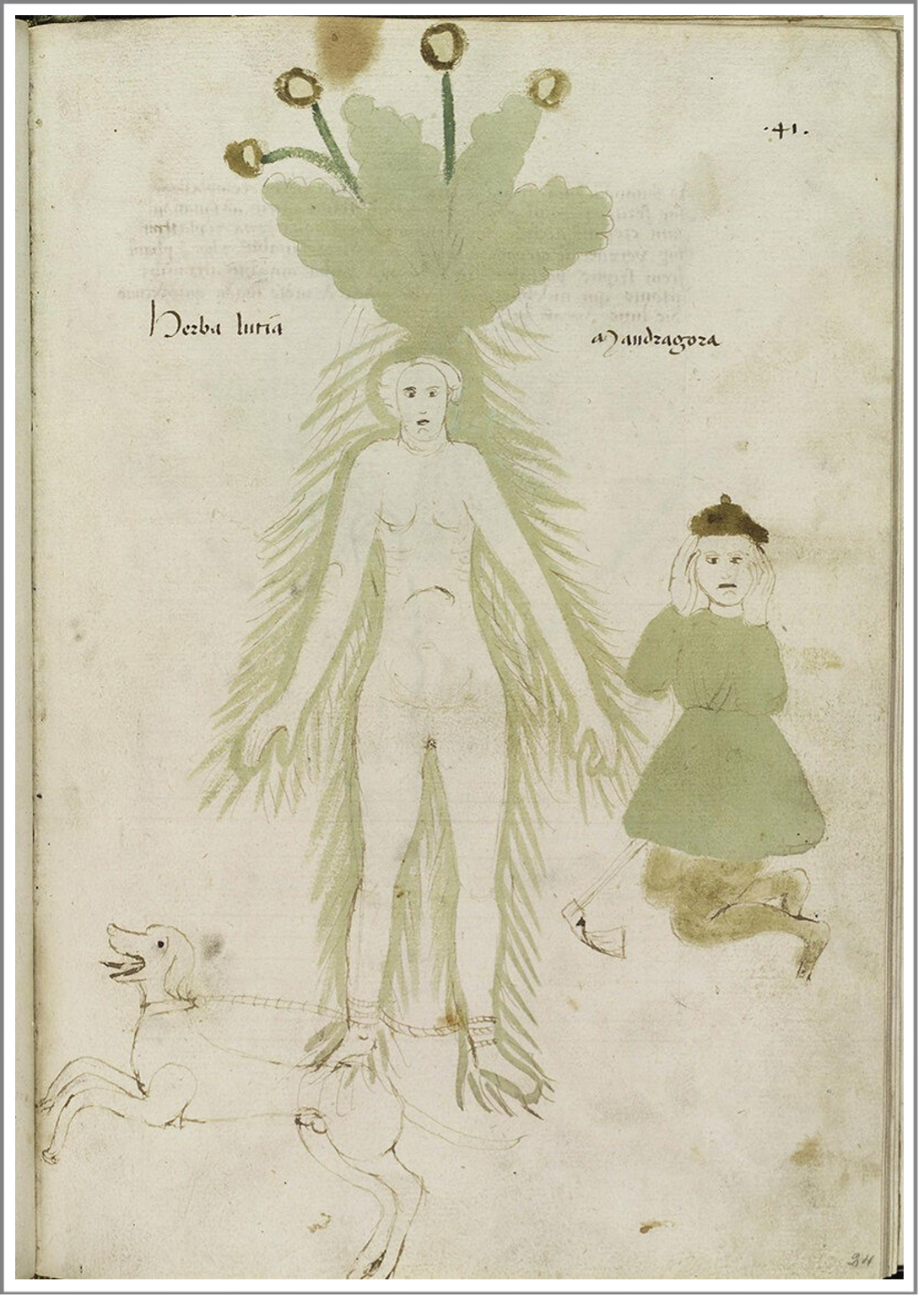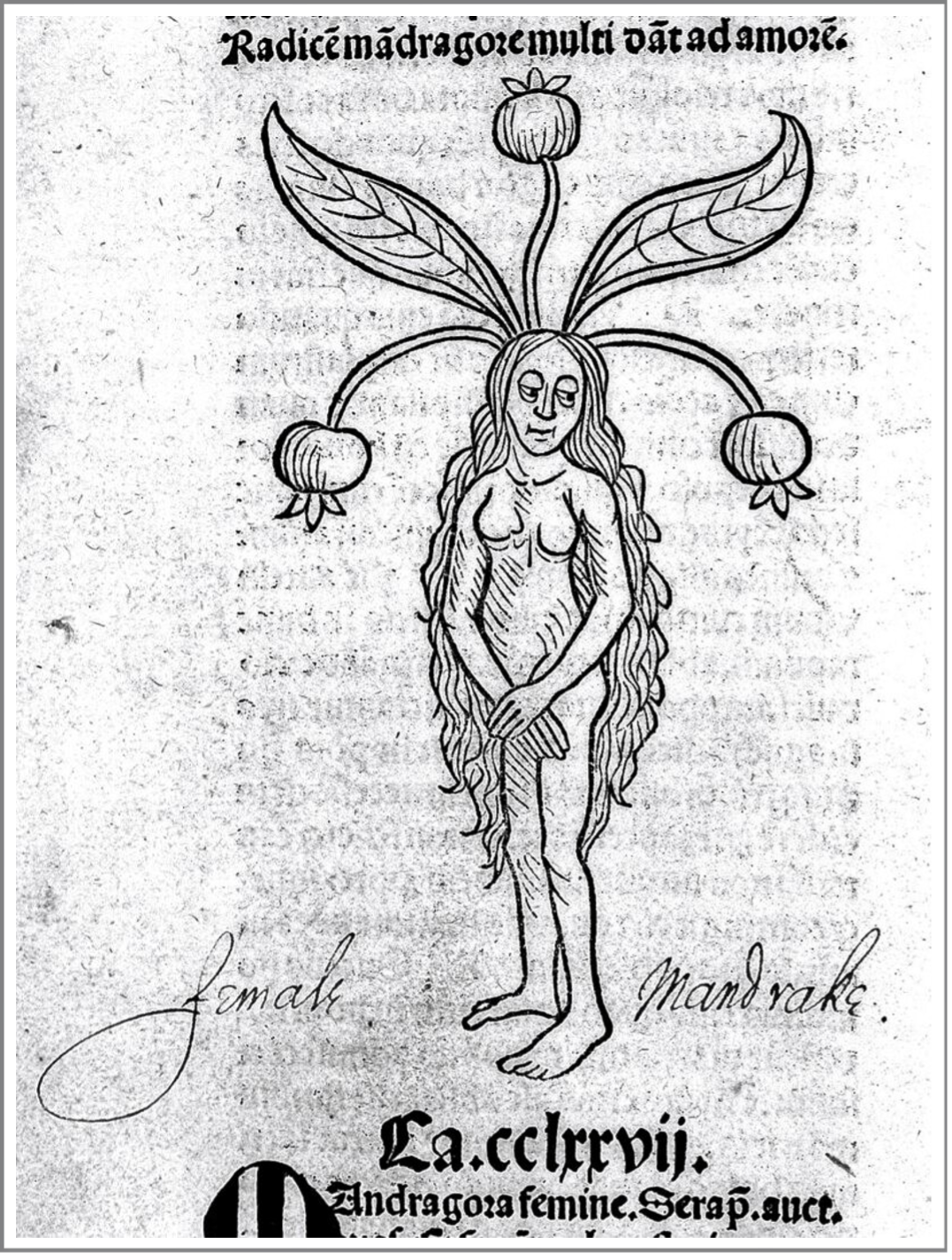By Asia Leonardi for the Carl Kruse Blog
Since ancient times, the Mandrake has been surrounded by legend, myth, alchemical rites and black magic. Over the centuries, various qualities have been attributed to this root: it is said to be magical, aphrodisiacal, an anesthetic. Among medicinal herbs, the Mandrake has perhaps most captured the imagination of people, becoming part of great literature and cinema: from Shakespeare to the Labyrinth of the Faun to Harry Potter.
In the Book of Genesis, the Mandrake’s root is used as an expedient by Rachel to conceive the children of Jacob. In Greek mythology, the sorceress Circe and the goddess Aphrodite make use of it for its aphrodisiac power. Today we know that the Mandrake, belonging to the family of solanaceae, contains hallucinogenic and anticholinergic substances.
14 And Reuben went in the days of wheat harvest, and found mandrakes in the field, and brought them unto his mother Leah. Then Rachel said to Leah, Give me, I pray thee, of thy son’s mandrakes.
15 And she said unto her, Is it a small matter that thou hast taken my husband? and wouldest thou take away my son’s mandrakes also? And Rachel said, Therefore he shall lie with thee to night for thy son’s mandrakes.
16 And Jacob came out of the field in the evening, and Leah went out to meet him, and said, Thou must come in unto me; for surely I have hired thee with my son’s mandrakes. And he lay with her that night. — the Bible, King James Version, Genesis 30:14–16
In the first century, the Greek physician and botanist Dioscorides wrote that in ancient Rome it was custom to dip Mandrake into wine, to obtain an anesthetic effect. However, he warned that its use had to be thrifty and careful: take too much of it and your rest will become eternal. Dioscorides, besides being one of the first sources to mention Mandrake, distinguishes two types: a “male” Mandrake, whose root is thick and pale, and a “female”, less voluminous and darker: today we know that he was referring to two different species, Mandragora officinalis and Mandragora autumnalis.
Over the centuries, the distinction between male Mandrake and female Mandrake was consolidated also by the anthropomorphic form of its root. In the Middle Ages, these beliefs formed the so-called doctrine of the signatures, according to which a plant that resembles a certain part of the body could be used to heal illnesses to that same part. The Mandrake was thought to resemble a complete human body, and therefore was believed to exercise control over the entire organism, it could generate love, and induce conception, bringing fortune, wealth, and well-being. If a woman wished to conceive a baby, a mandrake root in the shape of a child was slid under her pillows every night. A Mandrake in the shape of a woman kept in the pocket could help a man to win his beloved. Throughout Europe, in the Middle Ages, people sought mandrakes to solve troubles, and charlatans took advantage of them by producing counterfeits.

In the folk medicine of India, the Mandrake is known as Lakshmana, “the one which possesses lucky signs”, and is used as an aphrodisiac and in childbirth assistance.
In medieval Europe, Mandrake was credited with numerous epithets, such as “apple of Satan”, “testicles of Satan”, “apple of the fool” and “apple of love”. For Germans, it was known as Drachenpuppe, “dragon–puppet“, and Galgenmännlein, “little man of the forks“, while in Iceland as thjofarot, “root of the thieves“. Other denominations linked the plant to narcotic effects and witches.
In France, the Mandrake was known as the main gloire, “hand of glory“, or mandragloire, perhaps from the union of the words Mandragora and Magloire, the latter being the name of an elf of French folklore, personified as a root of labored Mandrake. In Britain, a legend tells of a nocturnal spirit appearing with flaming fingers. On the other hand, “hand of glory” is also the name given to the amputated hand of a dead man and used as a magic torch to commit night robberies. It is a popular theme of European folklore, appearing in treatises, witchcraft manuals, accounts of witch trials, and popular beliefs. For example, in Alberto Magno’s Book of Secrets, the author explains how to prepare a hand of glory. The purpose of the hand of glory is “[… ]to amaze those to whom it is shown and make them motionless as if they were dead”. This hand, cut from a dead and dried, was used as a candle holder for occult practices. It is said that the hand shines at night, just like the Mandrake, as the plant is under the forks and has a similar sleeping effect. In Antioch, Constantinople, and Damascus, human-shaped roots of Mandrake have been found. This seems to show that not only the use of the plant is ancient, but that there also was a desire to increase its “magical” power, changing its shape. Still in the modern age, in Armenia, it is common to burn Mandrake roots to drive away evil spirits from homes, and inhaling the smoke is considered a cure for madness. A kind of Mandrake is also used in magic rituals in Sikkim, in the Himalayas.

Woodcut of two Mandrakes
Other bizarre ancient traditions trace the birth of Mandrake to drops of semen or urine fresh from the body of a hanged man. For this reason, some considered it dangerous to collect. Other beliefs include the notion that a demon lived within a Mandrake and would wake once the root was extracted, his scream killing the unwary collector. Others believed that the cry, rather than that of an evil spirit, was attributable to the last scream of pain of the condemned to death.
In the Middle Ages, the myth of the Mandrake is enriched with further attributions: from a powerful ingredient for numerous magic potions to an infernal plant. The rediscovery of esotericism helped spread these beliefs and the Mandrake became a fundamental element in the attempts of theurgists, magicians, and alchemists to recreate life starting from inanimate matter. It is in this period that we find in alchemical texts miniatures and images that portray the plant and its root with real human appearance; the leaves and flowers modelling hair, while the root with its characteristic bifurcation recalling the trunk and legs of the human body.
According to a certain Middle Eastern tradition, perhaps antecedent to Christianity, the anthropomorphic root Mandragora is born in Paradise on Earth, where God created the first man. It would grow at the foot of the Tree of Good and Evil, with which it is sometimes identified. In this case, Mandrake is associated with a primordial place, where primeval creation takes place.
It is, therefore, a primordial and therefore mythical plant.

In different European, Arab, and Asian cultures, it is reported that man originated from Mandrake, based on the anthropomorphic aspect of the root:
“The first men would be a family of gigantic sensitive mandrakes, that the sun would animate and that, alone, would be detached from the earth, Man originally appeared on earth in the form of a monstrous mandrake, animated by an instinctive life, and that the breath of the Highest compelled, transmuted and rebuked, and finally uprooted, to make them beings endowed with thought and movement of their own”.
In a legend of Syria it is said:
“When God created the world, the creation of living beings was reserved on the earth, in the waters, and the air; but, in his contract with Satan, he had forgotten the underground. The spirit of evil, jealous of the Creator, also wanted to make men and women living under the earth. His inventive but incomplete genius led only to the shapeless shaping of the mandrake. Since these, torn from the ground, penetrate the kingdom of God, they cease to live”.

The first two stories refer to a pre-existing myth of the origin of man, in which its origin is after that of the plant. The plant has a sensitivity, proper to all living beings, then transmitted to man at the moment of his creation. The Syrian legend, however, recalls the theme of the miraculous birth mediated by supernatural intervention, in this case malignant.
As for the myths related to the use of Mandrake, we recall an account of ancient Egyptian religious literature, known as Destruction and Rescue of Mankind. The sun god Ra wants to punish men for not worshipping him and sends the goddess Hathor to kill them. But then he changes his mind and stops Hathor:
“Then said Ra: Call me the messengers who run swiftly, who hasten like the shadow of a body’. Then these messengers were brought in at once. And then said the Majesty of this God: Go to Elephantine, and bring me did it in quantity’. These didits were brought to him, and the Majesty of this great God caused the Chromate who dwelt in Heliopolis to grind these didits, and that the slaves also pressed barley for beer. So, these didits were placed in this drink, and it was like the blood of men. They made 7,000 jugs of beer. Then came the Majesty of the King of the Valley and King of the Delta Ra with these gods to see this beer. Now, the morning of the goddess’s killing of men came on the day they returned. Then said the Majesty of Ra: How beautiful this is! With this, I will protect men! ‘ Ra said: Take him to the place where she wants to kill men’. The Majesty of the King of the Valley and King of the Delta Ra rose early at the end of the night to pour this soporific drink. Thus were the fields submerged for three palms under the water, by the power of the Majesty of this god. Then came this early morning goddess, and found this submerged. Her face was beautiful, and she began to drink, and it pleased her heart, so that she was drunk, and she did not know men. Then said the Majesty of Ra to this goddess: Welcome in peace, beloved! ‘ And this was the origin of the Young Girls of Jamu. Then said the Majesty of Ra to this goddess: Let there be for her drowsy drinks in the celebration of the annual feast, and let them be distributed to the slaves’. This is the origin of making sleeping drinks in distribution to the slaves for the feast of Hathor by all men until the first day”.

This myth is not only the origin of a cultic use of Mandragora (didit), it is something more. It’s the story of the second birth of humanity, made possible through the power of the Mandrake.
As with all magical plants, the role of the Mandrake as a psychoactive species within its myths probably influenced their elaboration.
The special magical qualities attributed in the past to the plant of Mandragora were later analyzed by modern medical science. We know today that in this plant are found active pharmacological substances, such as scopolamine, atropine, and josciamina, which are still employed in the preparation of some medicines. The difference lies in the dosage, now calibrated and never left to the discretion of those who were in charge of its preparation, as happened in the past. The main property of this plant is, finally, the narcotic-sedative one, which is the ability to provoke a deep sleep and is particularly useful in countering the cough.
==============
The Carl Kruse blog homepage is at https://www.carlkruse.com
Contact: carl AT carlkruse DOT com
Other articles by Asia Leonardi include Fernando Pessoa, Variations of Beauty and the Beast, and on Frida Kahlo.
Carl Kruse is a member of the Richard Dawkins Foundation.
Is the Mandrake still popular in modern times/